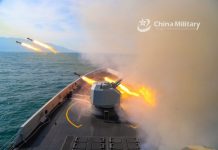The depleting fleet of the Indian Air Force is set to get a Rafale boost as India is set to receive 16 of the 36 fighter jets by April 2021. The next batch of three Rafale fighter jets will arrive in Ambala on 5 November from the Bordeaux-Merignac facility according to latest reports.
F-35 Fighter Jet Program – A Whooping 398 Billion Initiative Faces Full-Rate Production Delay
Unlike the last time, the jets will not be stopping anywhere as they will be fuelled mid-air, as per the senior government officials quoted by the Hindustan Times. So far, India has received five Rafale jets, three single-seater and two twin-seater, which were inducted into the force’s Golden Arrows squadron in September.
India will be receiving three more Rafale fighters in January, another three in March and seven in April 2021.
With this, the IAF will have 21 of these fighter jets, including seven twin-seaters. As by April 2021, the Golden Arrows Squadron will be equipped with 18 of these fighter jets and the remaining three will be sent to Hashimara airbase in north Bengal’s Alipurduar to protect the northeastern border with China.
The details on the arrival of rest of the jets have come after the senior officials of the Indian Air Force had reached France to review the progress earlier in October.
On India’s request, the combat-proven fighter jets will be now equipped with the air-to-ground modular weapon known as Hammer with a 250kg warhead. Earlier, the jets had Mica and Meteor air-to-air missiles along with Scalp air-to-ground cruise missiles.
India had purchased a total of 36 Rafale fighter jets from France in a 2016 government-to-government deal at a cost of $8.7 billion. The delivery of the jets will be completed by 2022.
India to Produce Fighter Jet Engines
Stating another big development between India-France cooperation, a report by the Hindustan Times has claimed that France’s biggest jet engine maker Safran is also ready to make fighter engines and ancillaries in India. The officials have welcomed Safran’s offer to make the Snecma M-88 engines in India.

The same engines can be used in the Defence Research and Development Organisation’s (DRDO) Light Combat Aircraft Mark II and twin-engine advanced multi-role combat aircraft.
Since the IAF is planning to buy 83 LCA jets, the DRDO will be continuing developing its own engines at a ramped-up pace and Safran engine will fill the gap between development and manufacture.
With the Safran offer, India will be the fourth country after the US, Russia and France which have the capacity to produce fighter jet engines. China still relies on Russian engines to power its J-31 and the JF-17 fighter jets.
The matter will likely be taken up during foreign secretary Harsh Shringla’s visit to France, the UK and Germany, starting from Paris on Thursday.
Lingering Border Stand-off
After the beginning of the military stand-off with China earlier in May, India had requested France to ensure timely delivery of the fighter jets, which were likely to be delayed due to the COVID-19 lockdown. However, France fulfilled its promise and delivered the first five of 36 jets in July.
While the last violent face-off between the Indian and Chinese armies took place in August end, the troops on both the sides remain engaged along the Line of Actual Control in spite of the onset of Winter in the Himalayas.
Speculating that the stand-off is to last longer, the two armies have been providing their soldiers with winter supplies and gear to deal with the sub-zero temperatures of the Himalayas.
Reports have claimed that an additional 35,000-50,000 troops have been deployed in eastern Ladakh to match the strength of the Chinese People’s Liberation Army in frontline bases.
China Study Group, the Indian government’s top policy-making body on China-related issues, has taken up for deliberation a proposal made by Beijing to end the deadlock.
During the seventh round of military-commander level meetings on 12 October, China had proposed moving back the armoured units of the two armies from border areas. New Delhi will be responding to the offer in next round of talks.




